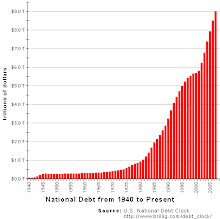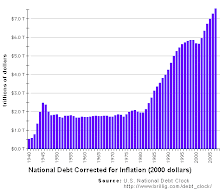Saturday, November 1, 2008
Monetary Policy - Topics
The primary macroeconomic policy goals are economic growth, low unemployment, and low inflation. The main tools to achieve these goals are monetary policy and fiscal policy.
Monetary policy is the central bank's use of the money supply, interest rates, and the loans generated by the banking system to influence the overall level of spending in the economy. The U.S. central bank is the Federal Reserve System (the Fed).
Click on the hyperlinks below to take you to a portion of the blog devoted to that topic:
Monetary Policy - Learning Objectives
Macroeconomic Policy Tools
How Monetary Policy Affects the Economy
Money and its Functions
Types of Money
Definitions of the U.S. Money Supply
Overview of the Federal Reserve System
Functions of the Federal Reserve System
Structure of the Federal Reserve System
Membership of the Board of Governors of the Federal Reserve System, 1914 to present
Instruments of Monetary Policy
Fractional Reserve Banking - An Introduction
Fractional Reserve Banking: How Required Reserves Keep the Banking System Solvent
Fractional Reserve Banking: The Relationships Between the Monetary Base, the Reserve Ratio, and the Money Supply
Fractional Reserve Banking: Using T-accounts to Illustrate How Banks Create Money
An example of how $100 of currency could create $1000 of money in the form of deposits in bank accounts if banks hold 10% of all deposits as reserves
How the Instruments of Monetary Policy Affect the Economy
Monetary Policy Instrument #1: the Required Reserve Ratio
Monetary Policy Instrument #2: the federal funds rate
Monetary Policy Instrument #3: open market operations
Example of How the Fed Uses an Open Market Purchase to Increase the Money Supply in a Fractional Reserve Banking System with 10% Required Reserves.
Example of Fractional Reserve Banking with 20% Required Reserves
Important Definitions Related to Monetary Policy
Monetary Policy - Questions for Further Study
...
Monetary policy is the central bank's use of the money supply, interest rates, and the loans generated by the banking system to influence the overall level of spending in the economy. The U.S. central bank is the Federal Reserve System (the Fed).
Click on the hyperlinks below to take you to a portion of the blog devoted to that topic:
Monetary Policy - Learning Objectives
Macroeconomic Policy Tools
How Monetary Policy Affects the Economy
Money and its Functions
Types of Money
Definitions of the U.S. Money Supply
Overview of the Federal Reserve System
Functions of the Federal Reserve System
Structure of the Federal Reserve System
Membership of the Board of Governors of the Federal Reserve System, 1914 to present
Instruments of Monetary Policy
Fractional Reserve Banking - An Introduction
Fractional Reserve Banking: How Required Reserves Keep the Banking System Solvent
Fractional Reserve Banking: The Relationships Between the Monetary Base, the Reserve Ratio, and the Money Supply
Fractional Reserve Banking: Using T-accounts to Illustrate How Banks Create Money
An example of how $100 of currency could create $1000 of money in the form of deposits in bank accounts if banks hold 10% of all deposits as reserves
How the Instruments of Monetary Policy Affect the Economy
Monetary Policy Instrument #1: the Required Reserve Ratio
Monetary Policy Instrument #2: the federal funds rate
Monetary Policy Instrument #3: open market operations
Example of How the Fed Uses an Open Market Purchase to Increase the Money Supply in a Fractional Reserve Banking System with 10% Required Reserves.
Example of Fractional Reserve Banking with 20% Required Reserves
Important Definitions Related to Monetary Policy
Monetary Policy - Questions for Further Study
...
Subscribe to:
Post Comments (Atom)






No comments:
Post a Comment